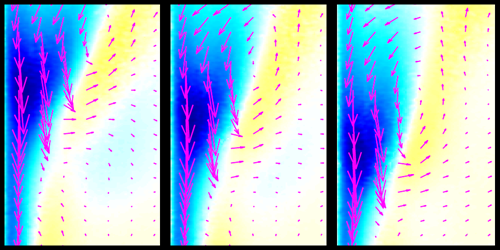Turbulent Jets Doubly Detrimental to Fluid-Based Batteries
Converting waste heat from renewable-energy technologies into electricity could reduce the need for fossil-fuel power stations—but only if that energy can be stored efficiently, for example, in a thermal battery. Researchers have partially solved this problem by designing batteries with vacuum insulation panels that reduce thermal leakage to the environment. But the useful energy available to the system can diminish even if environmental heat loss is reduced to zero. Now Christian Cierpka of the Technical University of Ilmenau, Germany, and colleagues have explored one such energy drain: mixing of hot and cold regions within a fluid-based energy-storage device [1]. The results could aid in the design of more-efficient thermal-energy-storage systems, potentially making such facilities useful as backups for intermittent renewable-energy sources.
The team studied mixing in a common thermal-energy-storage system in which a hot fluid reservoir sits atop a cold one. Between the reservoirs lies a transition layer with a temperature gradient across its width. The maximum energy output of such a battery depends on the temperature difference between the hot and cold reservoirs. Any drop in this difference will reduce the battery’s recoverable energy.
Under ideal conditions, the density differential between the hot and cold fluids should impede mixing, making such an arrangement relatively long-lived. But Cierpka and his colleagues observed that heat was conducted from the hot reservoir to the cold one via the battery’s sidewalls. This heat flow generated long, turbulent jets that traveled along the walls, moving hot fluid to the cold reservoir and vice versa. Analysis of the flow close to the walls indicates that the jets then triggered additional flow features that further mixed the hot and cold layers. The resulting evening out of temperature is detrimental to the technology, Cierpka says. He hopes that the observation will make scientists aware of fluid-mixing issues, which he says could be mitigated in future devices.
–Katherine Wright
Katherine Wright is the Deputy Editor of Physics Magazine.
References
- H. Otto et al., “Unsteady inherent convective mixing in thermal-energy-storage systems during standby periods,” PRX Energy 2, 043001 (2023).




